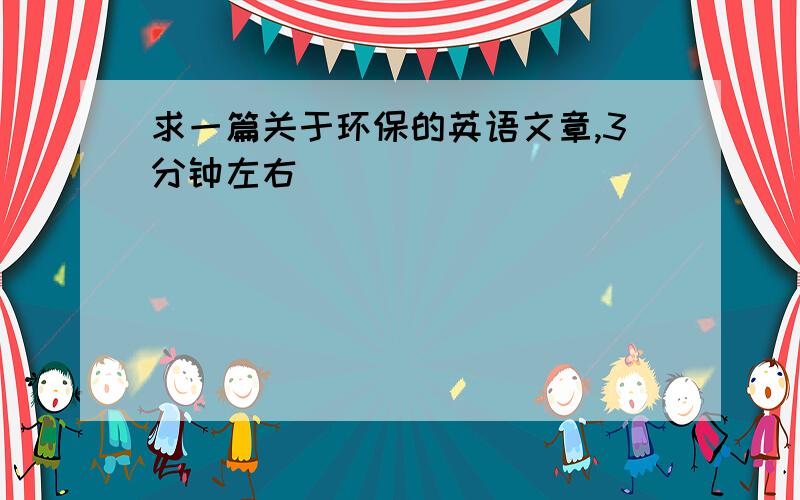求一篇关于环保的英语文章,3分钟左右
来源:学生作业帮助网 编辑:作业帮 时间:2024/11/18 09:22:06

求一篇关于环保的英语文章,3分钟左右
求一篇关于环保的英语文章,3分钟左右
求一篇关于环保的英语文章,3分钟左右
A new study warns that about thirty percent of the world's people may not have enough water by the year 2025.
一项新的研究结果提出警告:到2025年,世界上将有30%的人没有足够的水饮用.
A private American organization called Population Action International did the new study. It says more than three-hundred-thirty-five-million people lack enough water now. The people live in twenty-eight countries. Most of the countries are in Africa or the Middle East.
这项研究是由美国一家名叫“人口行动”的私立机构进行的.报告说现在世界上有三亿三千五百万人没有足够的水.这些人主要分布在非洲或中东的28个国家.
P-A-I researcher Robert Engelman says by the year 2025, about three-thousand-million people may lack water. At least 18 more countries are expected to have severe water problems. The demand for water keeps increasing. Yet the amount of water on Earth stays the same.
人口行动组织的研究人罗博特.安格曼说,到2025年大约三十亿人缺水.至少还有其他18个国家将可能面临同样严重的水短缺问题.人类对水的需求不断上升,但地球上水的还是保持不变.
Mr. Engelman says the population in countries that lack water is growing faster than in other parts of the world. He says population growth in these countries will continue to increase.
安格曼先生说,水短缺的国家的人口增长率要高于世界其他地区的人口增长率.他还说这些国家的人口出生率将持续增长.
The report says lack of water in the future may result in several problems. It may increase health problems. Lack of water often means drinking waters not safe. Mr. Engelman says there are problems all over the world because of diseases, such as cholera, which are carried in water. Lack of water may also result in more international conflict. Countries may have to compete for water in the future. Some countries now get sixty percent of their fresh water from other countries. This is true of Egypt, the Netherlands, Cambodia, Syria, Sudan, and Iraq. And the report says lack of water would affect the ability of developing to improve their economies. This is because new industries often need a large amount of water when they are beginning.
报告表明,在未来,水资源的缺乏可能会导致一些严重的后果.首先它可能会产生更多的健康问题.水资源的缺乏就意味着饮用水不再有保障.安格曼先生说,诸如霍乱等在水中传播的疾病会使世界出现许多问题.水缺乏也会引起更多的国际纷争.各国可能由于水而发动战争.现在有些国家,例如埃及,荷兰,柬埔寨,叙利亚,苏丹和伊拉克等,60%的纯净水是从国外进口的.报告认为水缺乏将影响发展国家发展经济的能力.这是因为新工业在开始阶段经常需要大量的水.
The Population Action International study gives several solutions to the water problem. One way, it says, is to find ways to use water for more than one purpose. Another way is to teach people to be careful not to waste water. A third way is to use less water of agriculture.
人口行动组织的研究报告为世界的水短缺问题提出了几个解决的办法.第一,找到多用途的用水方法.第二,教育人们不要浪费水资源.第三就是少用农业水.
The report also says long-term solutions to the water problem must include controls on population growth. It says countries cannot provide clean water unless they slow population growth by limiting the number of children people have.
报告同时表明,控制人口增长是长远解决水缺乏问题不可缺少的措施之一.它说除非各国能通过限制生育来降低人口的增长,否则它们不可能提供干净的水.
The hole in the ozone layer over Antarctica is about to start shrinking and will close by 2050, Australian researchers say.
Government scientists in Tasmania said scientific data showed the level of ozone-depleting chlorine in the atmosphere was declining because of the ban on the use of chlorofluorocarbons (CFCs) in fridges and air conditioners, agreed under the Montreal Protocol in 1987.
Dr Paul Fraser, the chief atmospheric research scientist with the Commonwealth Scientific and Industrial Research Organisation, said: "This is big news. We have been waiting for this. We think the trend is definite now. It is very significant."
Dr Fraser said that after the ban was adopted, the atmospheric level of chlorine continued to rise, peaking in 2000. "That was simply due to old refrigerators and old air-conditioners in cars," he says.
Since then, the level had stabilised and was now declining, albeit slowly, Dr Fraser said. He predicted that the hole in the ozone layer would contract steadily from about 2005 and disappear by mid-century, although the ozone would be vulnerable for a decade.
Under the Montreal Protocol, developing countries committed themselves to halving consumption and production of CFCs by 2005 and achieving an 85 per cent cut by 2007. The hole in the ozone layer, which protects Earth from the Sun's ultraviolet rays, was first detected nearly 30 years ago. It was then three times the size of Australia, itself covering nearly 3 million square miles.
澳大利亚一研究小组9月17日向全世界报告了一条好消息:南极洲上空的臭氧层空洞呈现出缩小的趋势,预计到2050年之前,这个巨大空洞就可以完全恢复了.
据塔斯马尼亚的科学家介绍,数据表明在大气层的消耗臭氧物质中,氯的含量正在下降.这应该归功于自1987年通过《蒙特利尔议定书》以来,人们在冰箱和空调设备中对吞噬臭氧的罪魁祸首--氟氯碳化物(CFCs) (一种含有氯、氟、碳三种元素的有机化合物,俗称"氟里昂")实行了全面的控制.
澳洲科学及工业研究机构(CSIRO)大气研究的主要负责人保罗·弗雷泽博士说:"这是个激动人心的消息.我们一直盼望着这一天.毫无疑问现在我们正在朝着这个方向前进,这个意义非比寻常."
弗雷泽博士还介绍说,即便在控制使用氟里昂后,大气中的氯含量还是在不断攀升,并在2000年达到了顶峰.他说:"这主要是由于冰箱和车载空调的普及所造成的."
直到2000年以后,氯气含量才停止增加并呈现缓慢下降的趋势.弗雷泽博士预测说,臭氧空洞将于2005年开始收缩变小,直到本世纪中期被完全填满,但填满后仍有十年属于比较容易被破坏的过渡期.
根据《蒙特利尔议定书》,到2005年,发展中国家氟里昂产品的消耗量和生产量都将减半,到2007年则减少85%,以此来保护我们的大气层.人们是在约30年前发现这个臭氧层空洞的.而臭氧层的作用主要是保护我们不直接受到太阳的紫外线辐射.30年来,臭氧层的这个空洞面积达到澳大利亚本土面积的3倍.而澳大利亚的本土面积为300万平方英里.
sos